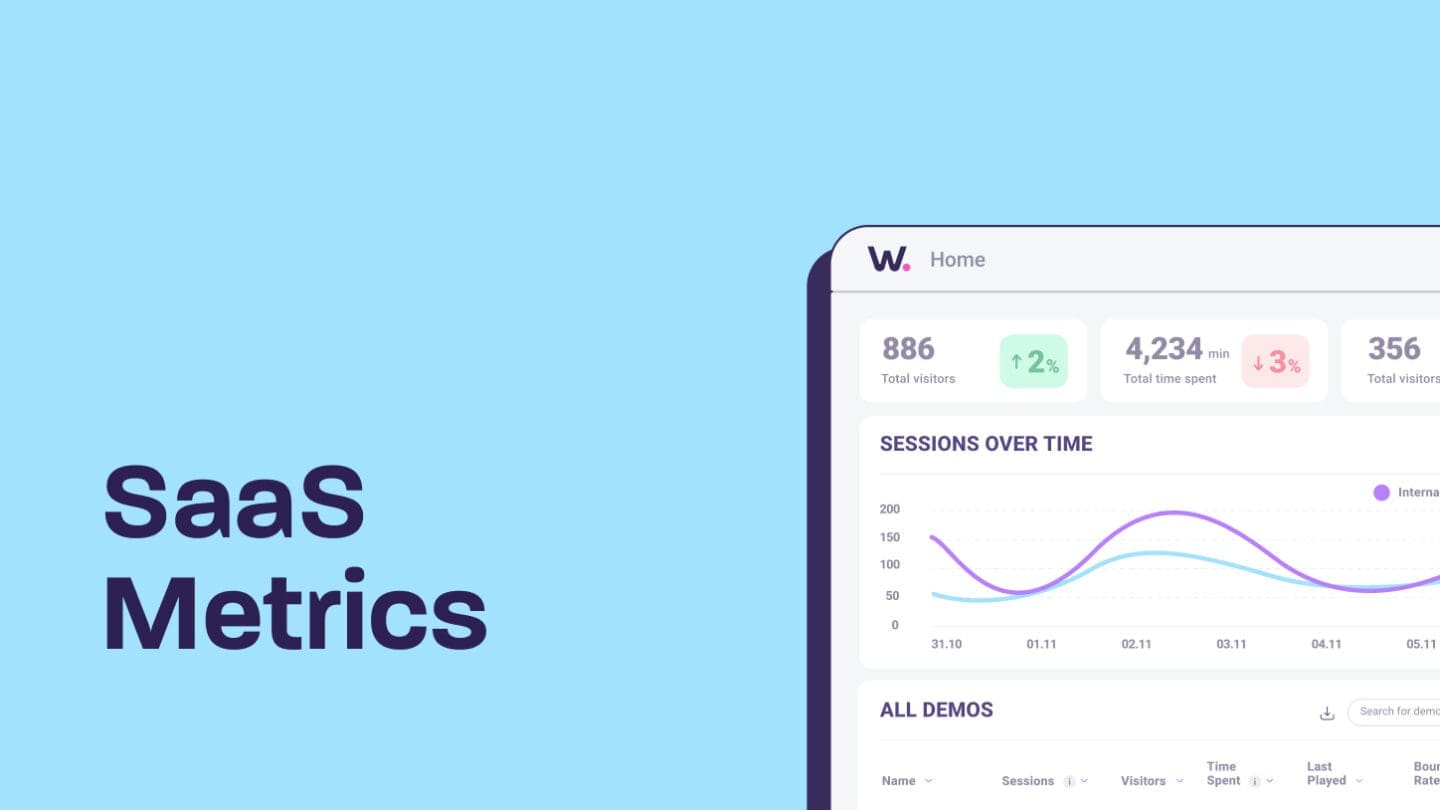Are you looking to understand sales enablement?
Well then, our goal is to enable you to understand sales enablement. To do that we’ll give you content and tips so you can accomplish your goal.
Sales enablement is crucial for SaaS because it helps sales teams perform better. It helps sales reps convert prospects into actively paying customers by providing them with tools and information to optimize their conversations and sales approach.
- What is sales enablement and why is it important?
- How to apply sales enablement for SaaS in 6 steps
- Step 1: Audit your current situation
- Step 2: Define your KPIs
- Step 3: Create your strategy
- Step 4: Improve collateral
- Step 5: Assign roles and responsibilities
- Step 6: Execute the strategy and create a feedback loop
- How to verify if sales enablement is successful: Key KPIs you should know
- Win/Loss Rate
- Ramp Time
- Cycle Length
- How to use Walnut to boost your SaaS sales enablement
What is sales enablement and why is it important?
Sales enablement refers to a field of content, products, and services that assists sales teams to better engage their audience, nurture leads, and convert their prospects.
The aim is to help the sales team increase conversions and reduce the time it takes for a lead to convert. Effective sales enablement gives your sales team the tools they need throughout the whole sale process, including training, collateral, tools, resources, and so on.
By equipping your team, sales enablement should:
- Increase close rates
- Reduce sales cycles
- Perfect sales processes
- Improve efficiency
How to apply sales enablement for SaaS in 6 steps
Here are the steps required to implement your sales enablement in your SaaS:
Step 1: Audit your current situation
The first step to determining what you are trying to achieve is by fully understanding where you are currently. To do this, you need to analyze your current goals and KPIs, determine how well they are working, and identify any issues that you need to overcome.
Task:
Interview, survey, and brainstorm with key stakeholders. Ask the following questions:
- Where are we now and what are our goals?
- What pains do we have that we’d like to solve?
- What do we know works?
- Where are our weaknesses?
- Which roles (AEs, SDRs, appointment setters) have the most success?
- What stage in our sales process can be improved?
Step 2: Define your KPIs
If you don’t know what you want to achieve, there’s no point in creating a sales enablement strategy and allocating resources to it. Once you’ve audited your current situation, you need to decide where you want to get to.
You can create SMART (Specific, Measurable, Achievable, Relevant, and Time-Bound) goals or KPIs to inform the sales enablement strategy based on the end goal. In other words, if you know where you want to get to, you can reverse-engineer the steps to get there, and you can measure success, as well as hold team members accountable.
We’ll cover sales enablement metrics in more detail below, but some examples of KPIs could include:
- Increase MRR by 50% in 2022
- Reduce sales cycles by 10% each quarter
- Boost product demo engagement by 50%
Task:
Define your sales KPIs. Make sure that they are SMART goals.
Step 3: Create your strategy
In step one, you have identified your current situation, and in step two, you’ve decided where you would like to get to.
You now need to translate that into a forward-looking strategy. Include the following sections in your plan:
- The people and teams that will be responsible for implementing the strategy, as well as which roles will have which responsibilities
- The resources required to enable sales content, training, and other tools (to be covered in more detail below)
- The KPIs you are aiming to achieve (for example, increase sales by 10% over six months or an additional $250,000 revenue in Q4)
- The steps (additional hires, new technology, more features, etc.) that will ensure you meet the end result
Task:
Write a clear strategy with your sales enablement mission and KPIs. Include where you want to get, who will own it, and the steps to get there. The document should be detailed but not overwhelming.
Step 4: Improve collateral
The strategy has outlined the resources you need to meet your KPIs, but you probably already have a ton of content you can use, improve, or eliminate from your processes.
Then, once you’ve optimized the materials you’re working with, you should take it a step further and locate the tech that’ll assist you with reaching your goals.
To meet your company’s needs, there are more sales enablement platforms than ever before. By determining the areas where you can improve you can start building your sales tech stack. Making sure you are using the right technology should be a priority for your SaaS company.
Start by auditing the resources available to your sales team:
- What are they currently sharing with prospects? Are they effective?
- Are the demos they share with prospects engaging?
- Are they using the best possible case studies?
- Is everything up-to-date?
- Is everything easily accessible?
- Analyze any data on the efficacy of the content
Task:
Improve all of the content required from the start of the sales cycle to the close, from email templates and demo scripts to contracts and pricing spreadsheets.
Implement interactive sales demos into your sales collateral to optimize the sales experience and give prospects the opportunity to try your product out for themselves early on in the sales process.
By making it easier and quicker for sales reps to send value-focused demos to prospects, you reduce their wasted time and improve efficiency. You also ensure that you send the best content to leads.
Step 5: Assign roles and responsibilities
This may sound obvious, but it’s super important that everyone is clear on their role and responsibility. For sales enablement to succeed, you need to make it easy for all of your team members to collaborate. This means keeping each member of the team updated on what exactly they are responsible for.
Task:
To do this, your sales enablement strategy should determine who/which department is responsible for what, for example:
- Creation of the resources: Sometimes the sales team will create these themselves, other times they’ll provide the information and have the marketing team create the resources. When it comes to creating demos, sales teams used to also rely on the help of developers. (Thank to Walnut, that’s no longer necessary.)
- Management of the process: Once the process is up and running, someone must be responsible for its management. It is usually the responsibility of the sales managers to ensure the team members follow the methods laid out in the strategy.
Step 6: Execute the strategy and create a feedback loop
You’ve created your strategy, allocated your team members, set up your resources, and you are midway through execution. The key now is to allow relevant team members to offer feedback and suggestions for improvement.
Once the program is in process, your sales team will understand what would help them, while marketing can input what is best for conversion rates. Remember, it’s not about creating a plan and sticking rigidly to it; it’s about working together to hit the end results.
Consider creating a sales enablement Slack channel and invite all relevant team members to join. Or create a weekly meeting to brainstorm ideas. The important thing is to keep communication open and learn from each other.
Task:
Create a regular schedule for feedback and open communication channels for all relevant team members.
How to verify if sales enablement is successful: Key KPIs you should know
We’ve covered what sales enablement is and how to implement it. Next, let’s determine how you will evaluate if your sales enablement program is a success. Here are the common KPIs to measure the success of your sales enablement processes:
Win/Loss Rate
The win/loss rate is the ratio of successful, winning opportunities compared to unsuccessful, lost opportunities. In other words, this KPI compares the opportunities you won against the opportunities you lost, putting wins and losses next to each other.
To determine the win/loss rate, divide the wins by the losses. It’s that simple.
Win/loss ratio formula: (Opportunities won) / (opportunities lost)
Ramp Time
Ramp time is the amount it takes for a new sales rep to complete training and ramp to full productivity and efficiency. The simplest way to calculate sales ramp time is to look at the length of your business’ sales cycles.
For instance, if your average deal takes two to four months to close, then your starting rep needs to be fully productive in two months. So, in this case, the sales ramp time formula is: (average sales cycle) + 60 days
You can also calculate sales ramp time by factoring in the training period and experience level. You must add the average time a training period lasts to the average sales cycle to the experience level.
For example, if you hire a sales rep with a three-month previous experience, you add this experience to the calculation. Sales ramp time formula when factoring in experience: (training period) + (average sales cycle length) + (experience level)
Cycle Length
A sales cycle is the time between the first contact with a prospect and finalizing a deal. Most businesses calculate the average sales cycle to create compelling sales forecasts.
Measuring this KPI is straightforward. Add the total number of days it took to close every deal and divide the results by the total number of deals.
For instance, if you were working on three deals:
- Deal 1 took 10 days
- Deal 2 took 20 days
- Deal 3 took 25 days
The average sales cycle would be 10 + 20 + 25 = 55 days in total, divided by 3 (the number of deals), giving an average sales cycle of 18 days.
How to use Walnut to boost your SaaS sales enablement
We hope that if you’ve read all the way to here, it’s become completely clear to you that sales enablement is fundamental for your SaaS company. Not only will it ensure that your sales team has all the collateral they need, but it will also ensure that more of your sales team’s efforts will be focused on actually winning deals.
Converting sales is all about providing your customers with an enjoyable and engaging sales experience. Walnut offers customizable interactive demos that your sales team can use on calls, or your marketing team can add to emails or your website.
The platform is completely codeless, crash-proof, and really easy to use. This way your sales reps can easily personalize demos for each prospect and let them experience your SaaS product early on in the sales process. This will shorten sales cycles and create a better experience for both sides.
You can also use Walnut’s in-built analytics to improve the overall sales enablement process by giving real information on how prospects interact with your product demo, sales, and other marketing efforts.
Ready to get cracking with Walnut? Book a meeting with us now by clicking that big purple “Get Started” button on the top of the screen.



